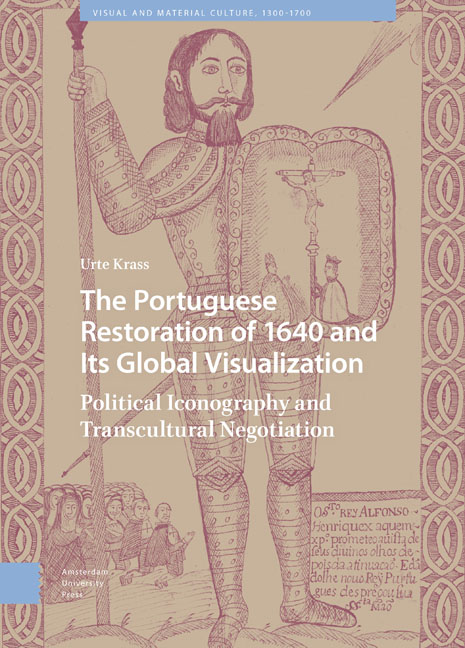 The Portuguese Restoration of 1640 and Its Global Visualization
The Portuguese Restoration of 1640 and Its Global Visualization Book contents
- Frontmatter
- Contents
- List of Illustrations
- Acknowledgments
- Introduction
- 1 Signs, Miracles, and Conspiratorial Images
- 2 The Lisbon Miracle of the Crucifix (1 December 1640)
- 3 The New King’s Oath (15 December 1640)
- 4 Acclamations
- 5 Lisbon
- 6 Images in Diplomatic Service
- 7 The Imaculada as Portugal’s Patroness
- 8 The Funeral Apparatus of John IV (November 1656)
- 9 The Drawings in the Treatise of António de São Thiago (Goa 1659)
- 10 Ivory Good Shepherds as Visualizations of the Portuguese Restoration
- Conclusion
- Bibliography
- Index
9 - The Drawings in the Treatise of António de São Thiago (Goa 1659)
Published online by Cambridge University Press: 13 February 2024
- Frontmatter
- Contents
- List of Illustrations
- Acknowledgments
- Introduction
- 1 Signs, Miracles, and Conspiratorial Images
- 2 The Lisbon Miracle of the Crucifix (1 December 1640)
- 3 The New King’s Oath (15 December 1640)
- 4 Acclamations
- 5 Lisbon
- 6 Images in Diplomatic Service
- 7 The Imaculada as Portugal’s Patroness
- 8 The Funeral Apparatus of John IV (November 1656)
- 9 The Drawings in the Treatise of António de São Thiago (Goa 1659)
- 10 Ivory Good Shepherds as Visualizations of the Portuguese Restoration
- Conclusion
- Bibliography
- Index
Summary
Abstract: Sometime after 1659, in Goa, the Capuchin friar António de Sao Thiago completed a treatise centered on the Vision of Ourique by the first Portuguese king, Afonso Henriques. The manuscript is preserved in two versions, containing twenty-two and twelve hand drawings, respectively. This chapter provides close readings of all the drawings and provides new models for some of them. Not only does the treatise develop transculturally intertwined coats of arms, explainable only against the simultaneous knowledge of European heraldry and Hindu pictorial practice, but the iconographies of specific coats of arms are used as arguments for Portugal's independence. Detailed comparisons of the drawings enable us to relate the two manuscripts to each other in a way that departs from the proposal of previous research.
Keywords: Goa, Vision of Ourique, Hanno the elephant, heraldry, Pope Innocent X, Pope Alexander VII
A manuscript extant in two versions recounts the history of Portugal from the Vision of Ourique to the Restoration and onward to the ascension to the throne of Afonso VI in 1657. It stems from the hand of a Franciscan living in Goa named António de Sao Thiago. The ink drawings in these manuscripts, presumably made by an Indian artist, are an integral part of their argumentation. One version of the manuscript is located in Harvard, the other version in Lisbon. They clearly derive from the same pairing of author and draughtsman, but they are not identical. There are passages in the Harvard manuscript that are missing in the Lisbon version, which also has fewer images. The treatise focuses on the translatio of the salvific mission from the ancient Israelites to the Portuguese, beginning with Afonso Henriques. Prophecies from the Old Testament are here cited to demonstrate that the Portuguese are the new apostles and missionaries, who are in the process of implementing a divinely ordained universal conversion. Above all, for António de São Thiago, the Portuguese have been chosen to missionize and convert the East, from where Christ's return was expected. This providential destiny would be fulfilled by the Braganza dynasty, a fact pointed to by the Portuguese monarchy's reconquest of many overseas territories that had been considered lost.
- Type
- Chapter
- Information
- The Portuguese Restoration of 1640 and Its Global VisualizationPolitical Iconography and Transcultural Negotiation, pp. 343 - 428Publisher: Amsterdam University PressPrint publication year: 2023


